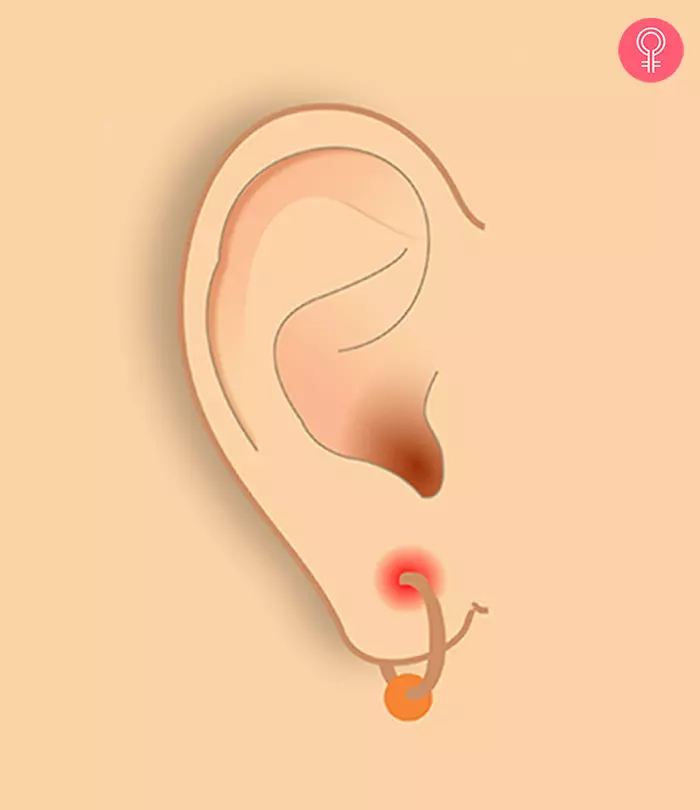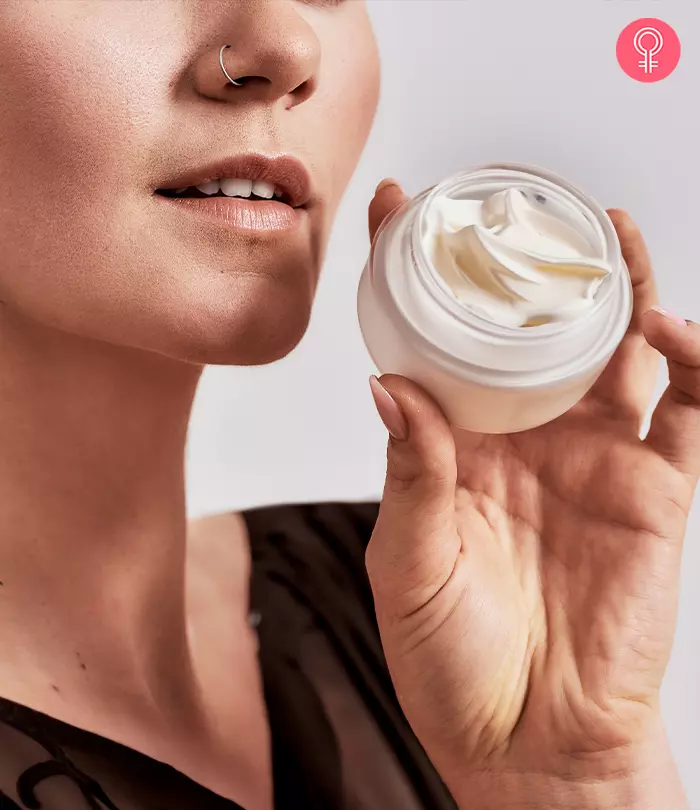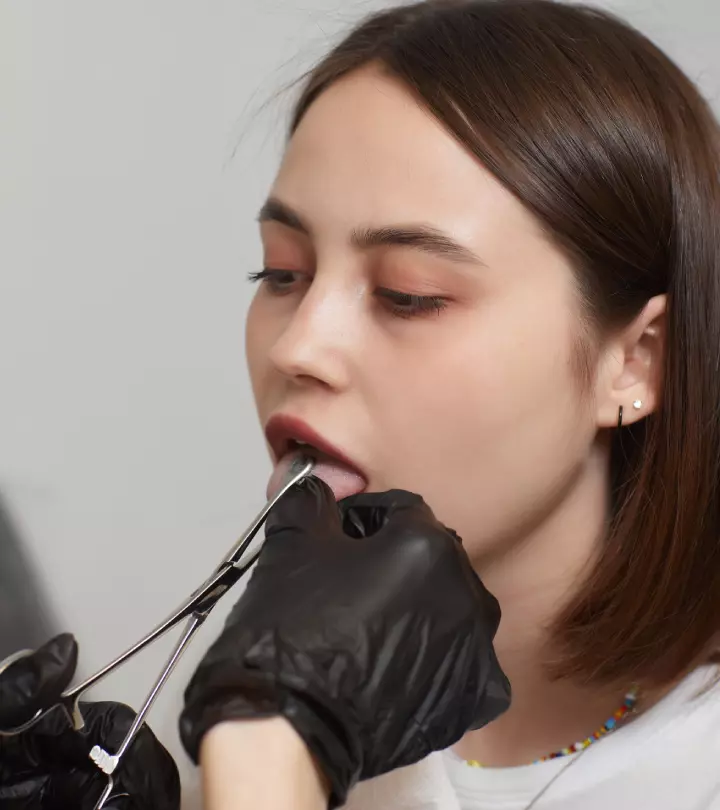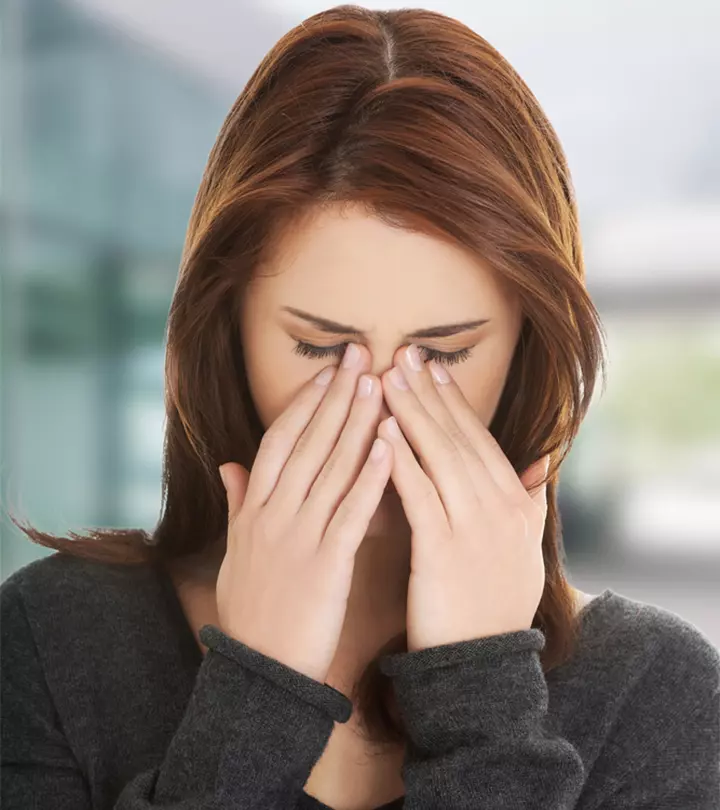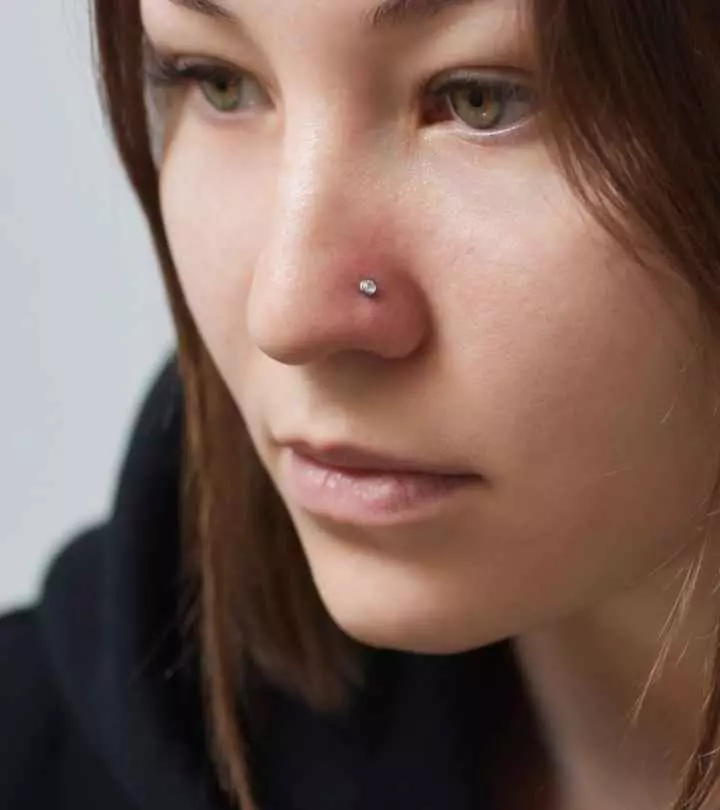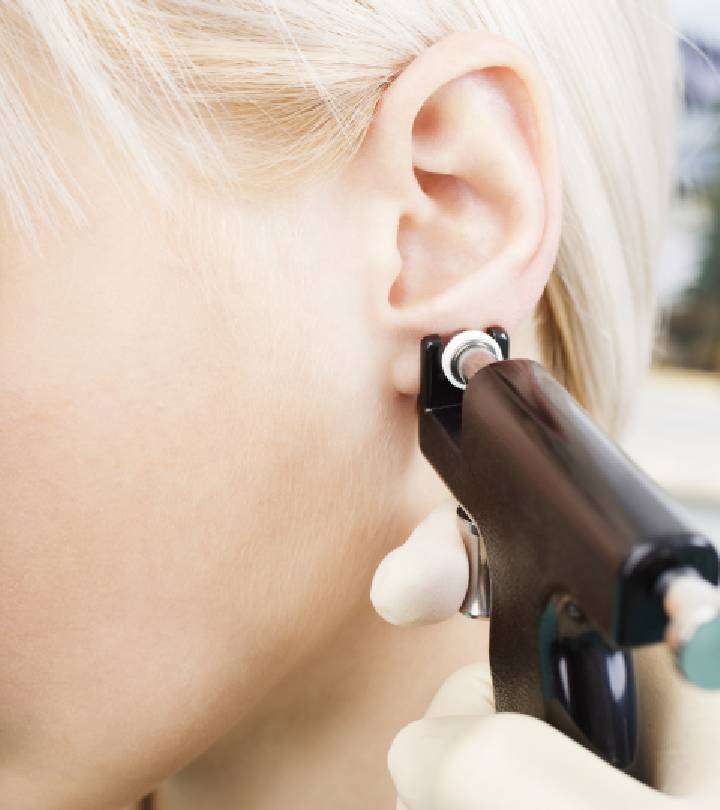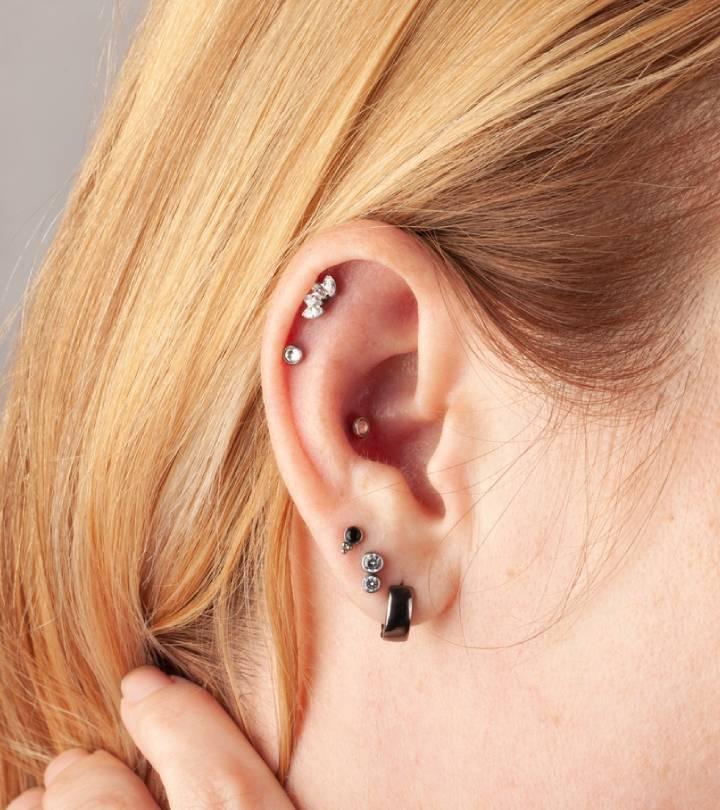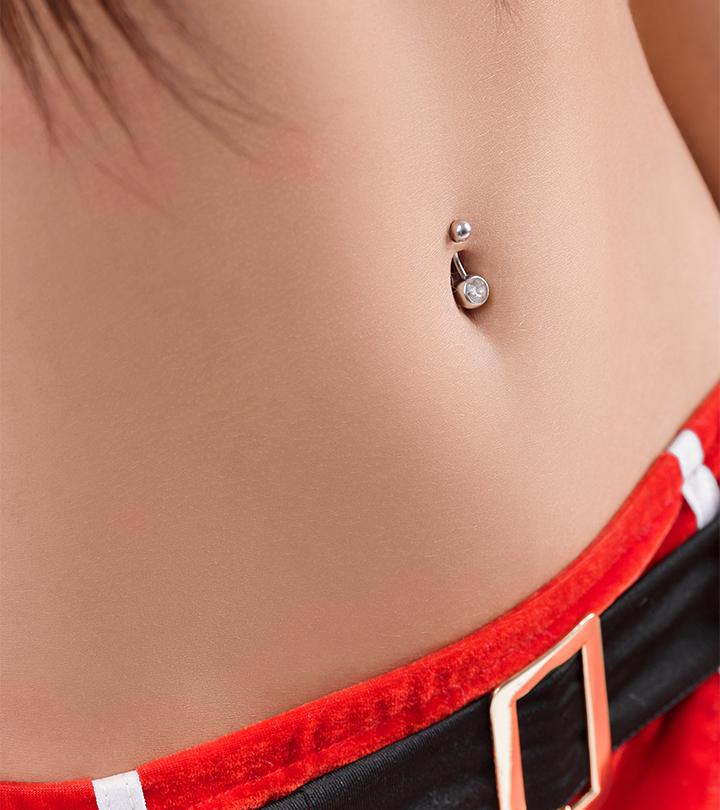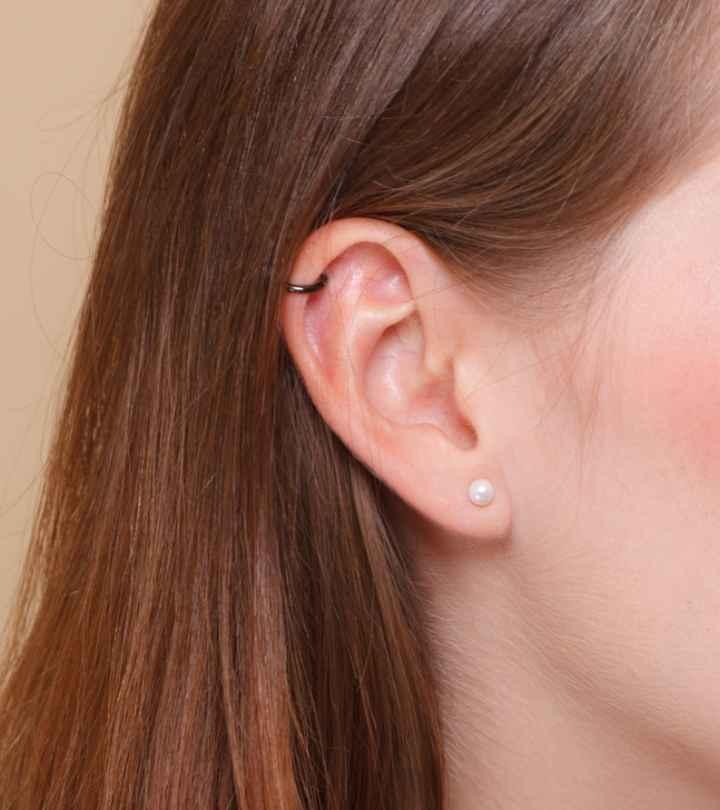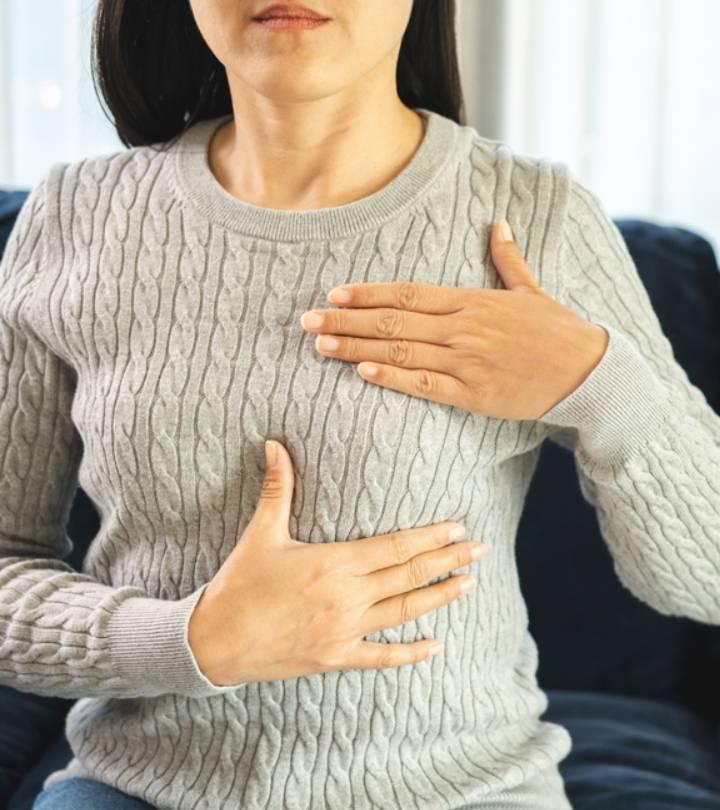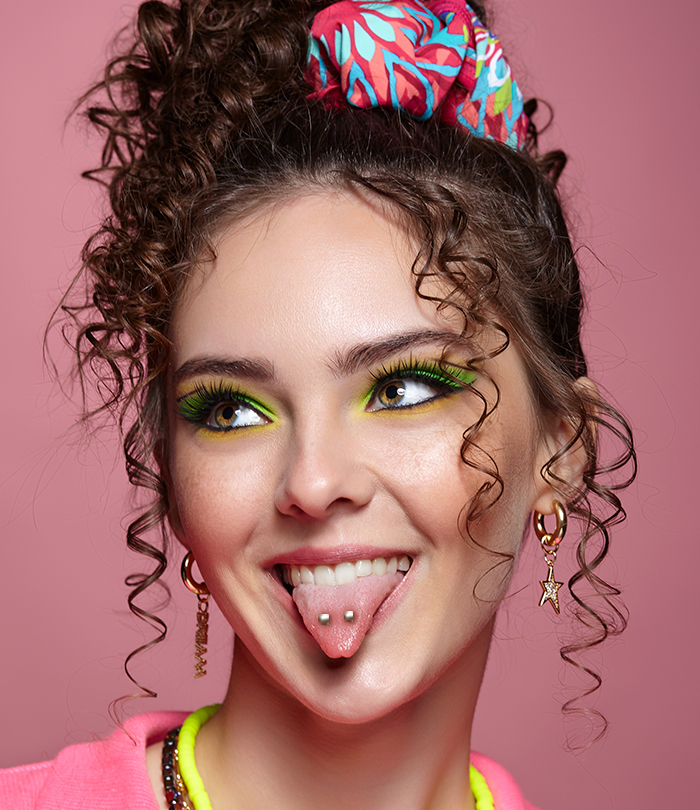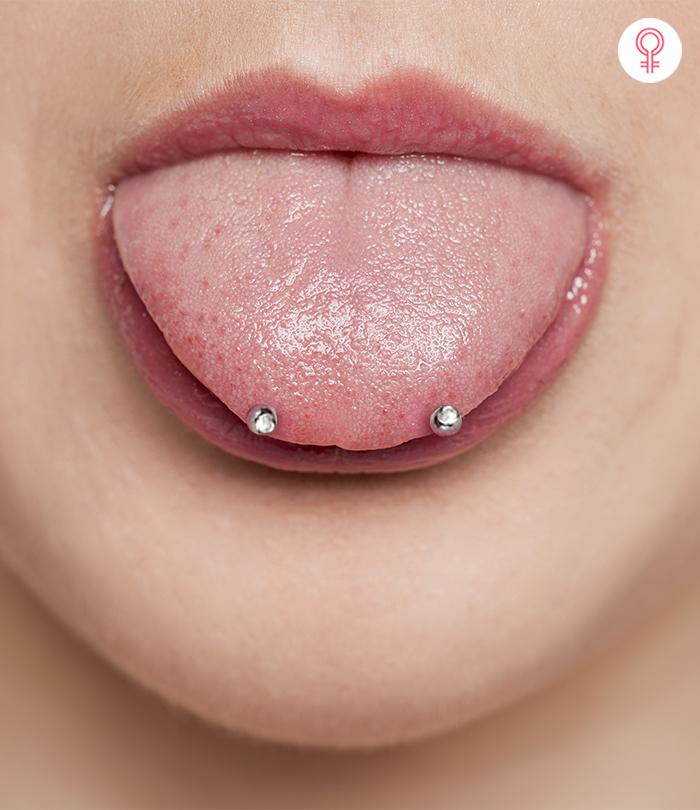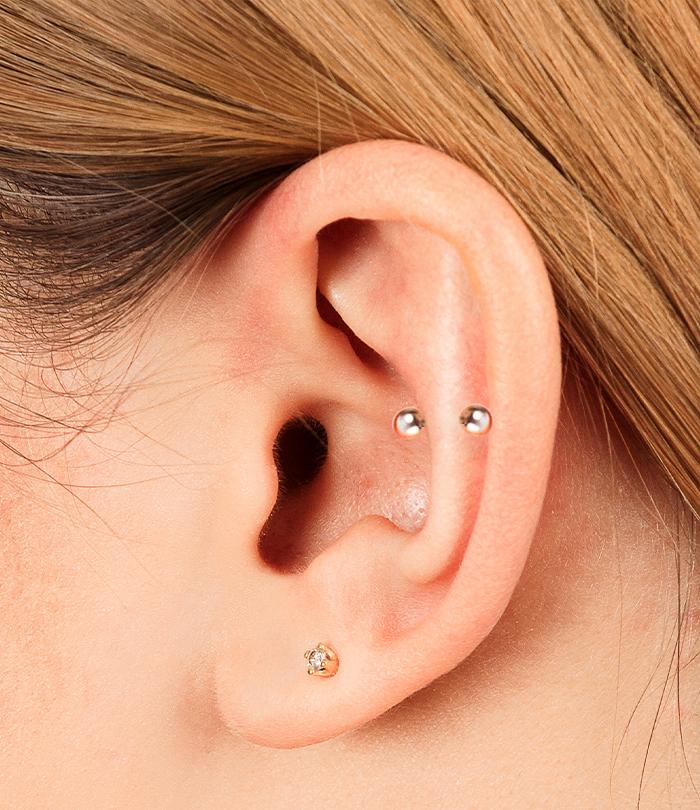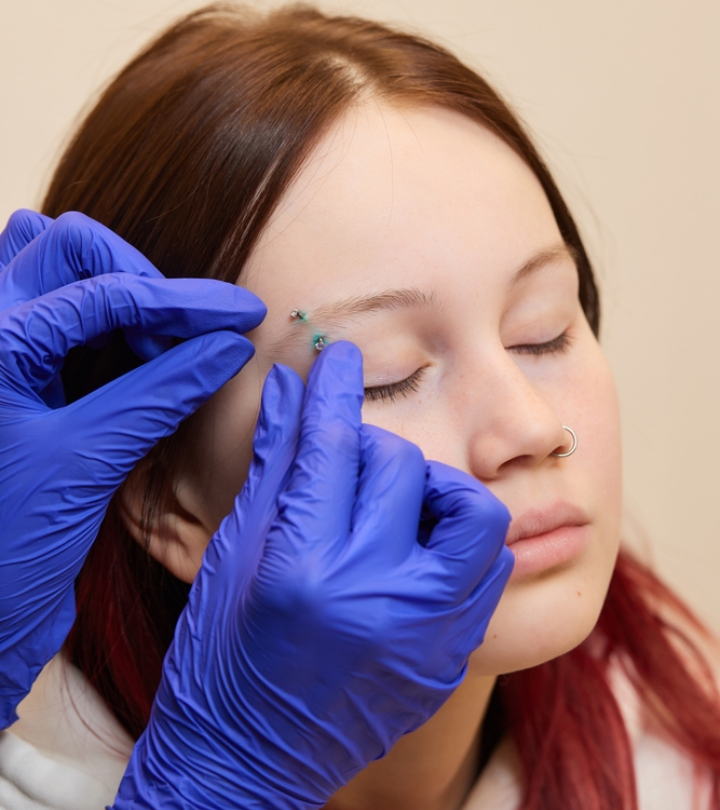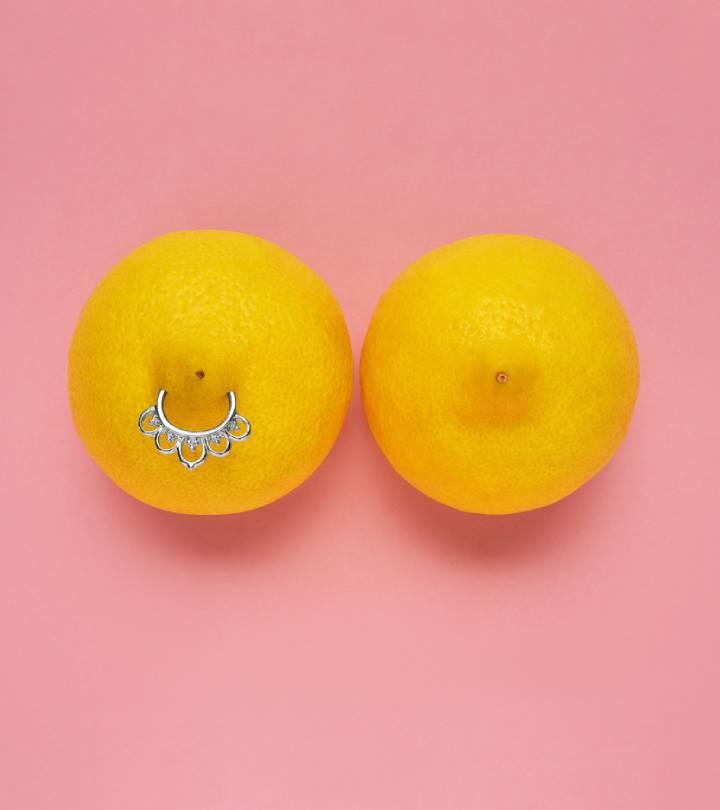Nose Piercing Bumps – Types, Causes, & How To Get Rid Of Them
Effective home remedies to help you remove and heal nose-piercing bumps.

Image: iStock
Nose piercing bumps can be painful and annoying. This reddish lump on the piercing site is common during the healing process. It occurs due to improper aftercare, piercing technique issues, and metal allergy. But do not worry. It is temporary and can easily be soothed at home. There are home remedies available to heal the swelling and redness. Keep reading to know more about the causes, remedies, and prevention tips.
 Quick Tip
Quick TipIn This Article
What Is A Nose Piercing Bump?
When you pierce your nose, you may notice redness and swelling on the piercing site after a few weeks. These bumps typically appear after a skin injury and often heal on their own. Yolanda Moore, MPAS, PA-C, says, “Bumps after a nose piercing can be caused by a variety of reasons that usually resolve at some point with the exception of keloids. Because keloids are scarring tissue caused by the trauma of the piercing, they tend to be more permanent. Most other bumps can improve with proper hygiene and simple remedies.”
Nose piercing bumps are mainly of three types. Learn more about them in the next section.
Types Of Nose Piercing Bumps
- Pustule: It is a pus-filled pimple-like bump on the pierced area.
- Keloid: It is a raised scar that develops at the piercing site. A keloid scar may appear like a bump.
- Granuloma: This type of bump is caused by tissue overgrowth. It may bleed and ooze white or yellow pus.
 Quick Tip
Quick TipNose piercing bumps may develop due to multiple reasons. Read the next section to find out the causes.
What Causes Nose Piercing Bumps?
- Improper Aftercare: If you have a new piercing, it is critical that you clean and sterilize it twice a day to prevent infection.
- Poor Personal Hygiene: You may develop bumps on the piercing site even after it has healed completely. This may be due to poor personal hygiene and touching the piercing without washing the hands.
- Poor Technique: Improper piercing technique can hurt the tissues and infect the area. Always go for a professional and reputable salon with licensed piercers.
- Allergic Reaction: This may be caused by products used before and after the piercing and metal allergy.
According to a national survey, around 35% of respondents had some form of body piercing. Women, on average, have more body piercings than males. The most common age group for body piercings is between the ages of 24 and 34. Approximately 23% of people with non-earlobe piercings experienced medical issues. It is concerning that one-third of people with body piercings had them done outside of a registered body art facility, increasing the risk of infection spread.
If you have developed a bump on the pierced area, it is better to visit a doctor for proper diagnosis and medication. You can also try these home remedies for redness and pain management at home.
How To Get Rid Of Nose Piercing Bumps: Home Remedies To Try
1. Sea Salt Solution
Sea salt has anti-inflammatory properties and may help reduce pain, swelling, and discharge from the piercing site (1).
How To Use
- Mix a tablespoon of sea salt in warm water.
- Wash the piercing site with the salt solution.
- Leave it on for a few minutes.
- Rinse it off and wipe the surface dry.
- Repeat it twice a day until the infection is gone.
Tinashe, a natural hair and lifestyle vlogger, shared her method of removing a keloidal bump from her nose piercing. She discussed her own experience with keloids and provided a step-by-step remedy using sea salt and warm water in a shot glass to soak the piercing. She says, “Trust me when I say this, that if you do this, your keloid bump will disappear within a couple of days or sometimes overnight (i).”
2. Tea Tree Oil
Tea tree oil has antimicrobial, anti-inflammatory, and antiseptic properties that can eradicate bacteria and reduce swelling, redness, and pain caused by nose piercing bumps (2).
How To Use
- Dilute 2-3 drops of tea tree oil with a tablespoon of any carrier oil (like coconut, jojoba, almond, or avocado oils).
- Apply it to the affected area with a Q tip.
- Leave it on and repeat the procedure twice a day until the bump has healed.
Note: Do a patch test to avoid allergic reactions.
3. Chamomile Tea Bags
Chamomile has anti-inflammatory properties and may help in reducing mild skin irritation, rashes, sores, and other skin inflammation (3). It calms the skin, relieving the irritation caused by the piercing.
How To Use
- Soak chamomile tea in warm water.
- Use the tea bag as a warm compress.
- Apply it for 5-10 minutes.
- Repeat the process several times a day.
4. Aspirin
Aspirin is one of the oldest medicines for pain and inflammation management. It helps reduce swelling, irritation, redness, and pain on the piercing site and promotes better wound healing (4).
How To Use
- Mix aspirin and water to make a paste.
- Apply it to the piercing site every night before going to bed.
- Repeat it once a day until the swelling heals.
5. Honey
Honey has long been used as a traditional remedy for skin infections and inflammatory conditions. It has antiseptic, anti-inflammatory, antimicrobial, and wound healing properties (5), (6).
How To Use
- Apply honey to the bump.
- Leave it on for at least 30 minutes (or longer) and wash it off.
- Repeat once or twice every day.
6. Cold Compress
Cold packs can reduce pain, swelling, and discomfort by constricting the blood flow to the injured site. They may provide temporary relief and make the bump less visible. However, do not apply the ice cubes directly to the area as it may worsen the infection.
How To Use
- Wrap the ice cubes in a clean white towel.
- Apply it to the piercing site for 15-30 minutes.
- Repeat this process 2-3 times a day.
7. Apple Cider Vinegar
Apple cider vinegar’s anti-inflammatory properties make it effective for soothing irritated skin. It can also provide relief from piercing-induced irritation (7).
How To Use
- Mix a solution of equal parts ACV and water in a small bowl.
- Dip a cotton ball or swab into the diluted ACV solution.
- Gently press the soaked cotton ball/swab against the bump caused by nose piercing.
- Hold it in place for about 5-10 minutes, allowing the solution to penetrate the bump.
- Rinse the area with warm water to remove any residue.
- Pat it dry with a clean, sterile cloth.
- Perform this treatment once a day until the bump reduces or disappears. Be consistent but gentle to avoid irritating it further.
While you can follow these remedies to soothe and heal nose piercing bumps, here are a few preventative tips to reduce the risk of developing them.
How To Avoid Nose Piercing Bumps: Prevention Tips
- Always Opt For A Professional Salon: A skilled piercer is well-versed in the craft, which decreases the likelihood of developing infections and bumps. Ensure that they use sterilized tools.
- Washing Hands Before Touching: This will ensure you do not pass on dirt and bacteria to the injured site. Avoid touching and poking the piercing frequently and change your sheets and pillowcases frequently to keep the piercing clean.
- Use Hypoallergenic Metal: Cheap jewelry may trigger an allergic reaction. To prevent that, opt for hypoallergenic metal jewelry made of gold, stainless steel, titanium, or niobium.
- Let It Heal: Nose piercing may take 6-8 weeks to heal. Do not remove or replace the nosepiece before complete healing.
Moore says, “Granulomas are common and will resolve with time and simple measures. Cleaning the piercing with saline, applying tea tree oil, and using Bactine antiseptic spray can help expedite the healing process. Other bumps (i.e., pustules) caused by infection due to inadequate cleanliness during the piercing process or poor piercing aftercare should be taken care of early and consistently until healed.”
Proper aftercare is crucial to avoid bumps and infection on the pierced area. Here are a few tips to keep the nose piercing clean.
How To Clean An Infected Nose Piercing
If you have an infected nose-piercing bump, it is important to take proper care of it to promote healing and prevent further complications. Here are some steps you can take:
- Wash and clean the area three to four times a day with a saline solution. Allow to dry it naturally, and do not use rubbing alcohol and hydrogen peroxide.
- Gently remove any debris or dry skin from the area.
Unless your doctor instructs otherwise, keep the piercing in place. If your infection hasn’t cleared up after a week, consult a doctor.
When To See A Doctor
Consult a doctor if:
- The pain doesn’t subside after two weeks.
- You experience fever, dizziness, and nausea.
- The bump feels tender or develops pus.
- The piercing area gives out a foul odor.
Moore says, “Most bumps will resolve over time if the cause is addressed properly. Unfortunately, keloid-related bumps may be permanent. One may consider consulting with a dermatologist or plastic surgeon to discuss corrective options for excessively large or disfiguring bumps.”
Nose piercing bumps or nose ring bumps are red, painful bumps that occur due to improper piercing technique, poor hygiene, or metal allergy. You can try simple natural remedies to reduce the redness and pain in the comfort of your home. You can apply a cold compress, tea tree oil, or honey to the piercing site to provide relief and quicken the healing process. Always go to a professional piercer and follow a proper aftercare routine to prevent the risk of developing nose piercing bumps. If the bump develops pus or gives off a foul smell after two weeks, consult a doctor.
Frequently Asked Questions
Can I pop the nose-piercing bump?
No, you should avoid popping the nose-piercing bump. It may make the infection severe and take more time to heal.
Should I put Vaseline on my nose-piercing bump?
No. According to anecdotal evidence, it is not recommended to apply petroleum jelly like Vaseline on your nose-piercing bump as it creates a barrier that may trap harmful bacteria and exacerbate your bump. It disallows the transfer of oxygen to the wound, thereby hindering the healing process. It may also clog the pores on your skin.
Key Takeaways
- There are three types of nose bumps – pustules, keloids, and granulomas.
- These bumps are caused due to bad piercing techniques, improper aftercare, inferior hygiene practices, and allergic reactions.
- Home remedies to treat bumps can be made with sea salt, tea tree oil, chamomile tea, and honey.
Discover the ultimate guide to piercing bumps in this comprehensive video. Watch now and empower yourself with knowledge for a successful piercing journey.
Personal Experience: Source
StyleCraze's articles are interwoven with authentic personal narratives that provide depth and resonance to our content. Below are the sources of the personal accounts referenced in this article.
i.How to get rid of a nose piercing bump/ keloid (fast!!!) | hellotinashe,https://www.youtube.com/watch?v=asfV0_W8q8o
References
Articles on StyleCraze are backed by verified information from peer-reviewed and academic research papers, reputed organizations, research institutions, and medical associations to ensure accuracy and relevance. Read our editorial policy to learn more.
- Anti-inflammatory Effects of Topical Formulations Containing Sea Silt and Sea Salt on Human Skin In vivo During Cutaneous Microdialysis
https://www.researchgate.net/publication/51151485_Anti-inflammatory_Effects_of_Topical_Formulations_Containing_Sea_Silt_and_Sea_Salt_on_Human_Skin_In_vivo_During_Cutaneous_Microdialysis - Melaleuca alternifolia (Tea Tree) Oil: a Review of Antimicrobial and Other Medicinal Properties
https://www.ncbi.nlm.nih.gov/labs/pmc/articles/PMC1360273/ - Chamomile: A herbal medicine of the past with a bright future (Review)
https://www.researchgate.net/publication/49658820_Chamomile_A_herbal_medicine_of_the_past_with_a_bright_future_Review - Aspirin in dermatology: Revisited
https://www.ncbi.nlm.nih.gov/labs/pmc/articles/PMC4693360/ - Honey: A Therapeutic Agent for Disorders of the Skin
https://www.ncbi.nlm.nih.gov/labs/pmc/articles/PMC5661189/ - Honey: A Therapeutic Agent for Disorders of the Skin
https://www.researchgate.net/publication/305890170_Honey_A_Therapeutic_Agent_for_Disorders_of_the_Skin - Home Remedy Use Among African American and White Older Adults
https://www.ncbi.nlm.nih.gov/pmc/articles/PMC4631220/
Read full bio of Dr. Enrizza Factor
- Yolanda Moore, MPAS, PA-C, is a physician assistant in Fresno, CA, with 15 years of experience. She currently practices at California Emergency Physicians and is a member of the California Academy of PAs and the American Med Spa Association.
 Yolanda Moore, MPAS, PA-C, is a physician assistant in Fresno, CA, with 15 years of experience. She currently practices at California Emergency Physicians and is a member of the California Academy of PAs and the American Med Spa Association.
Yolanda Moore, MPAS, PA-C, is a physician assistant in Fresno, CA, with 15 years of experience. She currently practices at California Emergency Physicians and is a member of the California Academy of PAs and the American Med Spa Association.
Read full bio of Anjali Sayee
Read full bio of Swathi E






